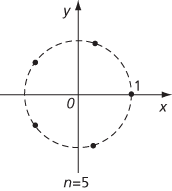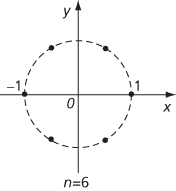A complex number z such that zn = 1. The n distinct nth roots of unity are ei2kπ/n(k = 0, 1,…, n−1), or
They are represented in the complex plane by points that lie on the unit circle and are vertices of a regular n-sided polygon. The nth roots of unity for n = 5 and n = 6 are shown in the figure. The nth roots of unity always include the real number 1 and also include the real number−1 if n is even. The non-real nth roots of unity form pairs of conjugates.


- Stockholm Convention
- Stockholm Convention on Persistent Organic Pollutants
- stocking rate
- stock market
- stock market crash
- Stock Market Crash (1929)
- stock option
- stockpile
- stock split
- stockwork
- Stoic
- stoichiometric
- stoichiometric coefficient
- stoichiometric combustion
- stoichiometric compound
- stoichiometric mixture
- stoichiometric sum
- stoichiometry
- Stoicism
- stokes
- Stokes, Adrian
- Stokes parameters
- Stokes radiation
- Stokes, Sir George Gabriel
- Stokes, Sir George Gabriel (1819–1903)